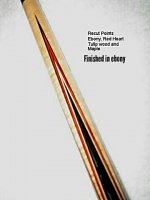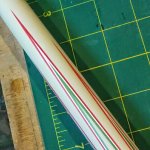You are using an out of date browser. It may not display this or other websites correctly.
You should upgrade or use an alternative browser.
You should upgrade or use an alternative browser.
Veneers or Recut? You like one better?
- Thread starter Shooter08
- Start date
I do recuts on my cues. Lots of time, but like the look, and use good hardwoods. Last year finished a cue for a guy who waited a while because it had 42 recuts in playing cue. Was a beautiful cue, thought about keeping it for myself. Am building him matching break cue and jump.
Old school veneers, just fine with me.Recuts just don't get me going like veneers, anyone else have a opinion?
All the best,
WW
Thank you very much.I like whatever Mike Webb does when he sends me pictures of his recent builds. Of course he does it because he knows I want one, and he isn't taking orders.
Recut points then overlapped veneers Elforyn on Elforyn then of course mitered.
Attachments
Would point recuts be so common these days if cue-makers did not have cnc?
I actually think that veneers *theoretically* can be stronger/more integrated into the vibration characteristics. This is with the grain going long as it usually does, and essentially fully parallel along the force lines. All with perfect joinery and glue technique. In recuts, the grain is different - it is not parallel to the slope, but more or less parallel to the axis of the cue. That probably sounds good. But what it means is that all the individual grain lines in the outer parts are cut off to short parallel sections. Rather than the grainlines running straight to the point. I would expect "on paper" for recuts to hit softer. In practice, depending on thickness and modern glue, i doubt it matters much either way.
Re-cut gives the opportunity for more spectacular compositions.
Per recuts vs inlays: really, what's the difference?
Suppose you used a fixture and made the entire set of recuts separately, then installed them in the cue. Then they would be an inlay. If you do them starting right in the cue itself as the "fixture", then it is all a recut. Even though it's the same structurally.
smt
I actually think that veneers *theoretically* can be stronger/more integrated into the vibration characteristics. This is with the grain going long as it usually does, and essentially fully parallel along the force lines. All with perfect joinery and glue technique. In recuts, the grain is different - it is not parallel to the slope, but more or less parallel to the axis of the cue. That probably sounds good. But what it means is that all the individual grain lines in the outer parts are cut off to short parallel sections. Rather than the grainlines running straight to the point. I would expect "on paper" for recuts to hit softer. In practice, depending on thickness and modern glue, i doubt it matters much either way.
Re-cut gives the opportunity for more spectacular compositions.
Per recuts vs inlays: really, what's the difference?
Suppose you used a fixture and made the entire set of recuts separately, then installed them in the cue. Then they would be an inlay. If you do them starting right in the cue itself as the "fixture", then it is all a recut. Even though it's the same structurally.
smt
That would be called. Milled one piece veneers.Suppose you used a fixture and made the entire set of recuts separately, then installed them in the cue. Then they would be an inlay. If you do them starting right in the cue itself as the "fixture", then it is all a recut. Even though it's the same structurally.
smt
Same effect except the discipline in doing it is different.
Ok, so traditional points use a square block that has thin veneers glued to it. a 90 degree v-groove bit cuts a pocket at an angle making a "point" and the "points" with the veneers stacked and glued on top of each other is layed at an angle into the pocket that is cut with the v-groove bit and glued in place. When it is turned round with the rest of the cue, it will look like what you think of as veneered points.could someone explain the difference please?
There are several ways of doing this. It can be done using mitered points, the line connecting the points of the individual veneers will be straightand centered on the tip of the point. It can be done with the veneers overlapping one another, in many cases difficult to tell the difference except to the discerning eye. Or veneered points may be done with a flat pocket (think Billy Stroud) and the points knifed and the veneers glued on straight to the points.
Recut points doesn't use veneers. Instead, you would cut the v-groove pocket, glue in a block at an angle and turn it on the cue, then you would cut another v-groove INTO the points you just glued in and turned. You do that several times and you get the look of veneered points without any glue lines connecting their ends.
Jaden
that's the short version explaining the difference.
Last edited:
Personally, I've rarely seen recuts done at a level equivalent to veneered points. I've never tried to do recuts myself either. While I have made traditional cues, I am currently going in a different direction; although, I will still be open to doing custom cues in a traditional way.
Jaden
Jaden
Really, the only way I could see doing truly phenomenal recuts would be to use a 4 axis cnc with a rotary axis. You would have to glue and turn each one without removing it from the rotary axis. The biggest problem with doing recuts is just what you said, getting the positioning accurate for subsequent recuts.They looks like recuts to me, no miters visible.
In my opinion, recuts are more difficult to do on a milling machine than putting together traditional veneers. They require extreme accuracy and a very stable machine to get uniform thickness, when showing the same width as veneers. Theoretically they will be stronger and less prone to lifting and separation in the long haul.
I may have to setup some g-code to try it and see what results I can get.
Jaden
p.s. There are techniques that can be used that will keep the alignment like making pilot holes to mount to so the piece lines up in the relatively exact same place.
Last edited:
Recuts or not? 1 deep V pocket cut in the forearm...17 pieces glued together in one setting. Any black veneers you see in any/all of my cues are one solid V piece of ebony.
Don’t need a cnc to do recuts. Mine are done on 40 year old mill.Would point recuts be so common these days if cue-makers did not have cnc?
I actually think that veneers *theoretically* can be stronger/more integrated into the vibration characteristics. This is with the grain going long as it usually does, and essentially fully parallel along the force lines. All with perfect joinery and glue technique. In recuts, the grain is different - it is not parallel to the slope, but more or less parallel to the axis of the cue. That probably sounds good. But what it means is that all the individual grain lines in the outer parts are cut off to short parallel sections. Rather than the grainlines running straight to the point. I would expect "on paper" for recuts to hit softer. In practice, depending on thickness and modern glue, i doubt it matters much either way.
Re-cut gives the opportunity for more spectacular compositions.
Per recuts vs inlays: really, what's the difference?
Suppose you used a fixture and made the entire set of recuts separately, then installed them in the cue. Then they would be an inlay. If you do them starting right in the cue itself as the "fixture", then it is all a recut. Even though it's the same structurally.
smt
Amen Mr. MaddenDon’t need a cnc to do recuts. Mine are done on 40 year old mill.
I do mine on a lathe with a repeatable dead center
Don’t need a cnc to do recuts. Mine are done on 40 year old mill.
Understood - like my 4 & 6 pt FS cues, i could do recuts on my 100 yr old planer, or 90 yr old shaper.
My question was "would they be so common".
IOW, How many are actually doing it on old machine tools like you & I use, or Mr Webb's engine lathe?
Or has the accessibility of 4 axis cnc opened up the option to many of the people doing it now?
I see (and commented above) that recuts offer a vastly increased opportunity for composition and more unusual grain patterns than veneers typically do. As a question to those doing recuts - was your choice driven by Art? Function? Or some particular of efficiency?
smt
Last edited:
For me, the need to know if I could define them, then do and understand them.As a question to those doing recuts - was your choice driven by Art? Function? Or some particular of efficiency?
smt
I like the aesthetic of recuts more than veneers. They look higher quality imo. I had a Skip Weston with them 15 years ago and the points were super nice.
For me, the need to know if I could define them, then do and understand them.
I can see that.
Also, i can see how they might be easier to add into a FS than making a veneer pack.
Still gonna have miters at the bottom end, though.
OH, sigh. Too many other projects to make headway on first.
smt
Understood - like my 4 & 6 pt FS cues, i could do recuts on my 100 yr old planer, or 90 yr old shaper.
My question was "would they be so common".
IOW, How many are actually doing it on old machine tools like you & I use, or Mr Webb's engine lathe?
Or has the accessibility of 4 axis cnc opened up the option to many of the people doing it now?
I see (and commented above) that recuts offer a vastly increased opportunity for composition and more unusual grain patterns than veneers typically do. As a question to those doing recuts - was your choice driven by Art? Function? Or some particular of efficiency?
I just like the clean look. I guess you would say matching the different woods on the recuts so you produce a good looking cue would be an art. And get a kick out of building different cue everytime.Understood - like my 4 & 6 pt FS cues, i could do recuts on my 100 yr old planer, or 90 yr old shaper.
My question was "would they be so common".
IOW, How many are actually doing it on old machine tools like you & I use, or Mr Webb's engine lathe?
Or has the accessibility of 4 axis cnc opened up the option to many of the people doing it now?
I see (and commented above) that recuts offer a vastly increased opportunity for composition and more unusual grain patterns than veneers typically do. As a question to those doing recuts - was your choice driven by Art? Function? Or some particular of efficiency?
smt


